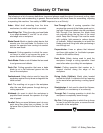
G0451 14" Sliding Table Saw
-11-
Below are tips to reduce the likelihood of
kickback:
• Never attempt freehand cuts. If the workpiece
is not fed perfectly parallel with the blade, a
kickback will likely occur. Always use the
rip fence or crosscut fence to support the
workpiece.
• Make sure the riving knife is always aligned
with the blade. A misaligned riving knife can
cause the workpiece to bind or stop the flow
of the cut, resulting in an increased chance
of kickback. If you think that your riving knife
is not aligned with the blade, check it imme
-
diately!
• Ensure that your table slides parallel with the
blade; otherwise, the chances of kickback
are extreme. Take the time to check and
adjust the sliding table.
• Use the riving knife whenever performing a
through cut. The riving knife helps maintain
the kerf in the workpiece after it is cut, there
-
fore, reducing the chance of kickback.
Even if you know how to prevent kickback,
it may still happen. Here are some tips to
reduce the likelihood of injury if kickback
DOES occur:
• Never, for any reason, place your hand
behind the blade. Should kickback occur,
your hand will be pulled into the blade.
• Stand to the side of the blade during every
cut. If a kickback does occur, the thrown
workpiece usually travels directly in front of
the blade.
• Always wear safety glasses or a face shield.
In the event of a kickback, your eyes and
face are the most vulnerable part of your
body.
• Use a pushstick to keep your hands farther
away from the moving blade. If a kickback
occurs, the push stick will most likely take
the damage that your hand would have
received.
Protecting Yourself
from Kickback
Statistics prove that most common acci-
dents among table saw users can be linked
to kickback. Kickback is typically defined
as the high-speed expulsion of stock from
the table saw toward its operator. In addi
-
tion to the danger of the operator or oth
-
ers in the area being struck by the flying
stock, the operator’s hands can be pulled
into the blade during the kickback.
Preventing Kickback
• Make multiple, shallow passes when per-
forming a non-through cut. Making a deep
non-through cut will greatly increase the
chance of kickback.
• Feed cuts through to completion. Anytime
you stop feeding a workpiece that is in the
middle of a cut, the chance of binding, result
-
ing in kickback, is greatly increased.


















